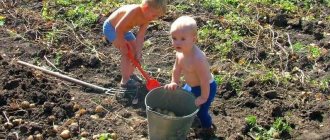Common, joint and collective work
The content of labor is realized in different forms of organization. Various forms of organizing the work of preschool children have been developed in science and put into practice: assignments; duty roster; common, joint, collective work.
1. Instructions are a request from an adult addressed to a child to perform some work action. An assignment is the first form of organizing work activity.
Work assignments can be:
- according to the form of organization - individual, subgroup, general;
- no duration - short-term or long-term, permanent or one-time;
- in content - correspond to the types of work.
Through assignments, it is possible to solve the problems of not only labor education, but also moral, physical, mental and aesthetic ones.
Instructions in junior groups are used for:
- maintaining interest in work, desire to work;
— training in labor skills and abilities;
- developing children's confidence in their strengths and abilities;
— satisfying the need to communicate with adults;
— preparation for other forms of labor organization.
Work assignments in senior groups are more complex in content, implementation and degree of responsibility for the result. Along with instructions that involve one action, those that include several interrelated actions are also used. It is very important for future schoolchildren to learn to independently think through the organization of their work and the sequence of carrying out assignments.
The teacher can very tactfully help with advice and hints, but be sure to show that the child himself is able to think through how he will carry out the assignment, where he will start, what materials and tools he will need, where he will take them and where he will put them after finishing the work. . Attention is drawn to conscientiousness, accuracy of execution, and completion of the task. The teacher especially highly appreciates the manifestation of creativity, invention, and the desire to bring joy to others.
2. Duty involves the work of one or more children in the interests of the entire group. On duty, to a greater extent than on assignment, the social orientation of work and the real, practical care of several (one) children for others are highlighted. Therefore, this form promotes the development of responsibility, a humane, caring attitude towards people and nature.
In preschool practice, duty in the canteen, in the “Nature Corner”, and in preparation for classes has already become traditional. The teacher pays attention to the pace and quality of work. He especially appreciates manifestations of creativity, the child’s desire to bring joy to other people through his work.
Duty duty contributes to the systematic inclusion of children in the labor process.
The duration of duty varies depending on the type of work, the age of the children, and the educational purpose.
Sometimes educators get carried away by this form of work organization and unreasonably expand its types. This should not be done. This kind of activity turns into control of some children over the behavior of others. The moral development of preschoolers is harmed, and the main meaning of duty is lost - caring for others.
3. General, joint, collective work primarily contributes to solving the problems of moral education. Already acquired work skills and abilities are only consolidated, and learning new ones is carried out, as before, individually. The teacher should not introduce into the content of general work something that the children do not yet know how to do.
General, joint and especially collective work creates favorable conditions for developing in children the ability to coordinate their actions, help each other, establish a uniform pace of work, etc.
What unites common, joint and collective work is the socially oriented goal of children's activities. This means that the result of work is always beneficial for everyone.
Common work involves organizing children's work in such a way that, with a common goal, each child performs some part of the work independently.
Joint work involves the interaction of children, the dependence of each on the pace and quality of the work of others. The goal, as in common work, is the same.
Collective can be called a form of labor organization in which children, along with labor ones, also solve moral problems: they agree on the division of labor, help each other if necessary, and “fear” for the quality of common, joint work. The collective form is called collective because it contributes to the purposeful education of collective relationships.
So, not every common and not even every joint work is collective. But every collective work is common and joint. It is important that the teacher is well aware of this and knows how to organize truly collective work of children.
Common work is possible already in the middle group of a preschool institution, joint and collective work - in high school and preparatory school. Maintaining children's interest in collective work is facilitated by conscious acceptance of its motive and purpose. Traditionally, collective work is organized once a week.
INTRODUCTION
Work becomes a great educator when it enters the lives of our students, gives the joy of friendship and camaraderie, gives birth to new beauty in the world around us, awakens the first civic feeling - the feeling of the creator of material wealth, without which human life is impossible
V.A. Sukhomlinsky
Friendship is a form of interpersonal relationships based on common interests and mutual affection. In preschool children, friendly relationships begin to develop in the process of communication in the kindergarten group. The beginning of a child's friendship is a valuable manifestation of humane feelings and real actions that include responsiveness, a desire to take into account the interests of a friend, and to protect him. Issues of nurturing friendly relationships, the importance of nurturing friendship in preschool children were covered in the works of many prominent teachers and psychologists: R.S. Bure, L.S. Vygotsky, A.D. Kosheleva, A.S. Makarenko, D.V. Sergeeva, and other authors who noted that it is necessary to cultivate friendly relations in children from preschool age. And in kindergarten there are many opportunities for this: in the process of everyday communication with peers, children learn to live in a team, master in practice moral standards of behavior that help regulate relationships with others. At the same time, it is necessary to pay great attention to the independently arising associations in children, to the content and forms of their communication, to look for ways in activities that allow children to learn how to interact, communicate, and make friends correctly. Along with play and artistic creativity, collective work is one of the means that promotes the development and education of preschool children. Work gives the child the opportunity to show real concern for other people, and also instills the skills of cooperation and collectivism - the ability to work together and amicably, helping those around him. At the same time, it should be noted that in the process of managing work, teachers pay more attention to the formation of labor skills and the ability to work independently. Therefore, the search for effective methods and techniques that promote the formation of friendly relationships among children in the process of work is relevant. A wide range of relationships are formed between preschool children during games, joint work activities and in classes. Feelings of sympathy and friendliness appear in children very early. The nature of children's relationships depends mainly on the conditions of upbringing in the family and kindergarten. The teacher encourages children's friendship and at the same time cultivates relationships that are not limited to the interests of only two or three children who are friends with each other, but are of great importance for the development of friendly relations among all students in the group. With this approach, friendly expressions of preschoolers acquire a truly humane orientation and contribute to their cohesion. When a child enjoys work, he strives to achieve good results. This makes the child’s character strong-willed and purposeful. Work brings out good qualities in children. Work done on one's own and worthy of praise brings satisfaction and pleasure to the child. Work should enter a child’s life joyfully and help in successful all-round development. In the process of labor activity, a person not only changes nature, but also changes himself. Work influences the development of a person’s mental abilities; It is in work activity that a person demonstrates his creative activity, develops, and improves his creative inclinations. In the process of labor, a person’s moral relations are formed, his physical improvement occurs, and his labor skills develop. The topic of labor has long been of concern to the best minds of humanity. Below are some thoughts and statements about the work of famous cultural, scientific and political figures. . “Nothing ennobles a person like work. Without work, a person cannot maintain his human dignity” (L.N. Tolstoy); . “Work is the father of pleasure” (Stendhal); . “Work saves us from three great evils: boredom, vice and want” (Voltaire);
. “By the degree of greater or lesser respect for work and by the ability to evaluate work ... according to its true value, you can determine the degree of civilization of the people” (N.A. Dobrolyubov);
. “Idlers rarely visit a busy person; flies do not fly to a boiling pot” (B. Franklin);
. “Work does not dishonor a person; Unfortunately, you come across people who disgrace work” (U.S. Grant);
. “If a slacker doesn’t annoy you, then you are something like him” (E.W. Howe).
. “Hunger looks into the house of a worker, but is afraid to go there” (B. Franklin); . “Labor created man himself.” (F. Engels). “Idleness accelerates the onset of old age, work prolongs our youth” (A.K Tselvis). “A person must work, work hard, no matter who he is, and in this alone lies the meaning and purpose of his life, his happiness, his delight.” (A. Chekhov). “If a person has acquired the habit of work from an early age, work is pleasant to him. If he doesn’t have this habit, then laziness makes work hateful.” (K. A. Helvetius). “Man is born to work; work constitutes his earthly happiness, work is the best guardian of human morality, and work should be a person’s educator.” (K.D. Ushinsky) What do we know about labor?
. If a person’s labor creates a result that is very significant for people, then this is work that is highly needed by people.
. If a person’s labor creates something that is not very significant for people, then this work, in general, is not very necessary for people. Thus, the problem and relevance of the above determined the choice of the research topic “Cultivating friendly relationships among preschoolers at work.”






